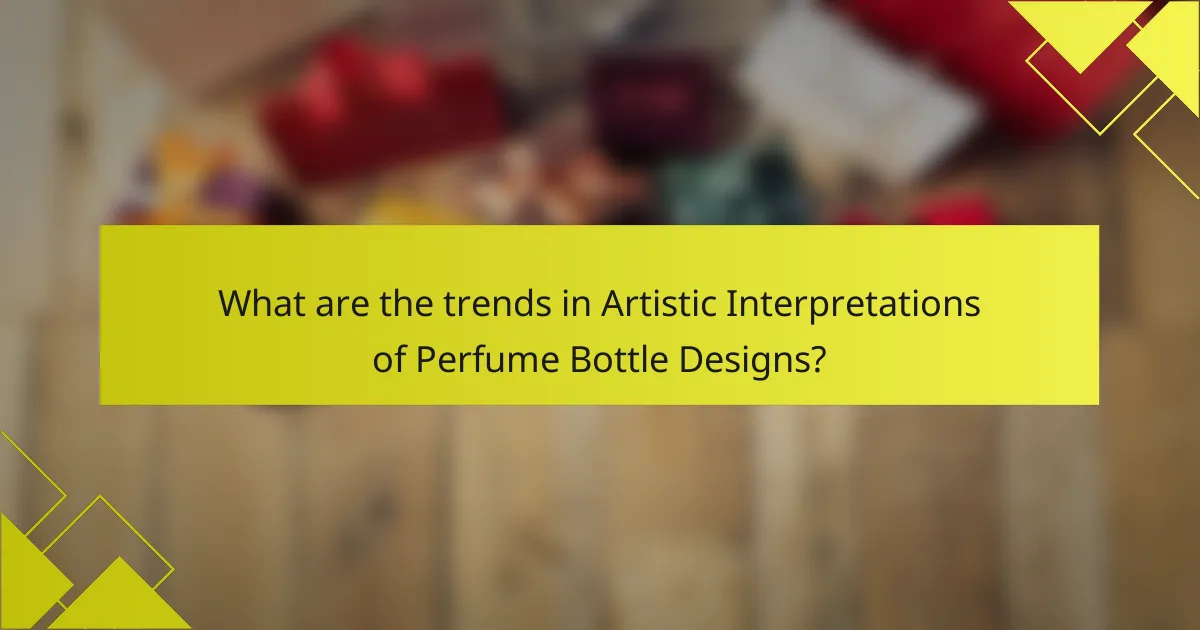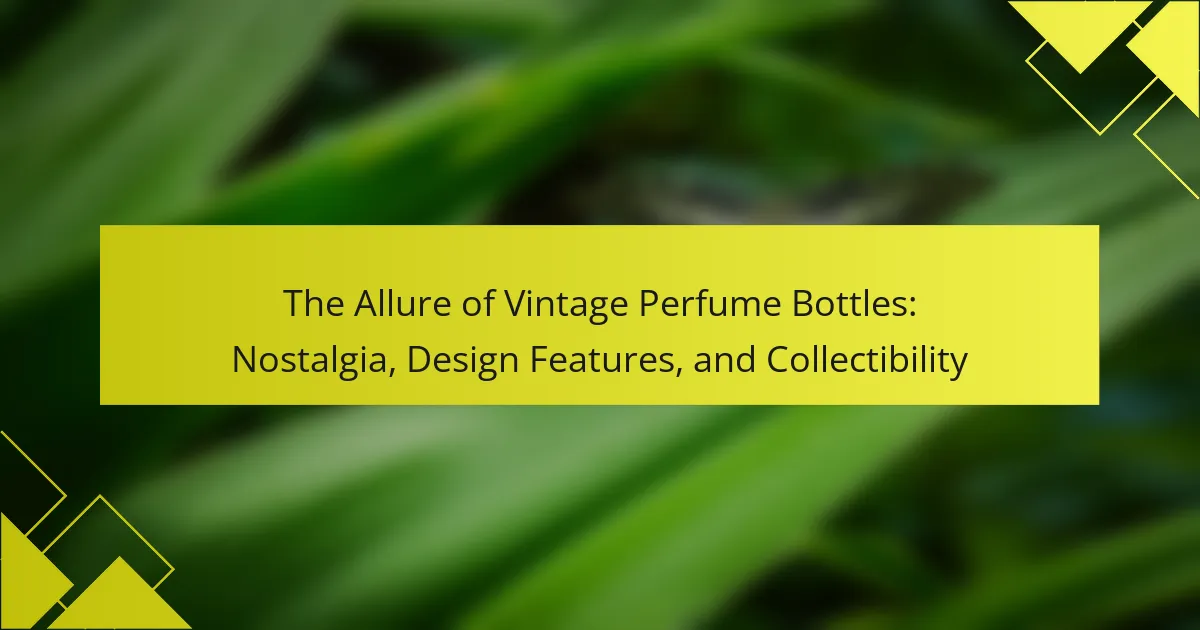
What are Artistic Interpretations in Perfume Bottle Designs?
Artistic interpretations in perfume bottle designs refer to unique and creative expressions that transform functional containers into works of art. These designs often incorporate elements from various artistic movements, reflecting cultural influences and individual artist styles. Collaborations between fragrance brands and artists lead to limited edition bottles, enhancing the aesthetic appeal and collectible value. For instance, renowned brands like Lalique and Baccarat have produced bottles that are celebrated for their craftsmanship and artistry. The design philosophy behind these interpretations emphasizes the fusion of beauty and functionality, often resulting in visually striking and innovative forms.
How do artistic interpretations influence perfume bottle aesthetics?
Artistic interpretations significantly influence perfume bottle aesthetics by shaping their form, color, and overall design. These interpretations often draw from various art movements, such as modernism or surrealism. For instance, the collaboration between designers and artists can result in unique bottle shapes that reflect the artist’s vision.
The use of color in these designs can evoke specific emotions or themes associated with the fragrance. For example, bold colors may suggest vibrancy, while muted tones could imply elegance. Additionally, limited edition releases often feature artistic designs that enhance the collectible nature of the bottles.
Historical examples include the iconic Lalique bottles, which showcase intricate glasswork inspired by nature and art nouveau. These artistic elements not only enhance visual appeal but also create a narrative around the fragrance. Ultimately, artistic interpretations elevate the perfume bottle from a mere container to a work of art, influencing consumer perception and desire.
What are the key elements of design in artistic perfume bottles?
Key elements of design in artistic perfume bottles include shape, material, color, and functionality. The shape often reflects the brand’s identity and can range from classic to avant-garde forms. Materials used can vary, including glass, metal, and ceramic, each contributing to the aesthetic and tactile experience. Color plays a significant role in conveying the fragrance’s essence and attracting consumers. Additionally, functionality is crucial; the bottle must effectively dispense the perfume while maintaining its artistic integrity. These elements combine to create a unique visual and sensory experience, enhancing the overall appeal of the product.
How do colors and shapes contribute to the artistic interpretation?
Colors and shapes significantly influence artistic interpretation in design. Colors evoke emotions and set the mood. For instance, warm colors like red and orange can create feelings of excitement or passion. Cool colors such as blue and green often convey calmness or tranquility. Shapes also play a crucial role in conveying messages. Geometric shapes can suggest order and stability, while organic shapes may evoke a sense of fluidity and naturalness.
Research shows that color psychology impacts consumer behavior. A study by Satyendra Singh in 2006 found that up to 90% of snap judgments about products can be based on color alone. This illustrates the power of color in shaping perceptions. Furthermore, the interplay between color and shape can enhance the overall aesthetic appeal of an object. In perfume bottle designs, these elements work together to create a unique identity, reflecting the brand’s essence and artistic vision.
Why are collaborations with artists significant in perfume bottle design?
Collaborations with artists are significant in perfume bottle design because they infuse creativity and uniqueness into the product. Artists bring fresh perspectives and innovative ideas that can transform traditional designs. This collaboration often results in limited edition bottles that become collector’s items. Unique designs can enhance brand identity and attract a broader audience. For example, collaborations with renowned artists like Salvador Dalí have produced iconic bottles that are celebrated for their artistic merit. Such partnerships elevate the perception of the fragrance, making it not just a scent but also a work of art. Additionally, they can create a narrative that resonates with consumers, adding emotional value to the product.
What types of artists are commonly involved in these collaborations?
Visual artists, graphic designers, and sculptors are commonly involved in these collaborations. Visual artists contribute unique aesthetics and concepts to perfume bottle designs. Graphic designers focus on branding and label creation, enhancing visual appeal. Sculptors often create three-dimensional forms, adding artistic depth to the bottles. Additionally, fashion designers may collaborate to integrate wearable art into the bottle design. These collaborations often aim to elevate the product’s artistic value and market appeal. For instance, renowned brands like Lalique and Chanel have partnered with famous artists to create limited-edition bottles.
How do artist collaborations enhance brand identity?
Artist collaborations enhance brand identity by infusing creativity and uniqueness into products. These partnerships allow brands to leverage the artist’s distinct style and vision. This results in limited edition designs that attract attention and create exclusivity. For example, when a renowned artist designs a perfume bottle, it transforms the product into a collectible item. This collaboration often resonates with the artist’s audience, expanding the brand’s reach. Additionally, it aligns the brand with the artist’s values and aesthetic, strengthening emotional connections with consumers. Such collaborations can also generate buzz through marketing and social media, further enhancing visibility. Ultimately, artist collaborations create a memorable identity that differentiates the brand in a competitive market.

What are Limited Runs in Perfume Bottle Designs?
Limited runs in perfume bottle designs refer to the production of a small, exclusive quantity of bottles. These limited editions are often created to celebrate special occasions or collaborations with artists. They are characterized by unique designs or features that distinguish them from standard offerings. Limited runs can enhance the collectibility of a perfume, appealing to enthusiasts and collectors. Brands may produce these limited editions to create a sense of urgency and exclusivity. The scarcity of these bottles can increase their value over time. Such strategies are common in the luxury fragrance market, where uniqueness is highly valued.
How do limited runs affect consumer perception of perfume bottles?
Limited runs enhance consumer perception of perfume bottles by creating a sense of exclusivity. This exclusivity often leads to increased desirability among consumers. Limited editions are perceived as unique and collectible. Consumers may associate these bottles with higher quality and craftsmanship. Brands often leverage this perception to justify premium pricing. According to a study by the Journal of Consumer Research, scarcity can elevate perceived value. This phenomenon is evident in the luxury perfume market, where limited runs often sell out quickly. Overall, limited runs significantly shape consumer attitudes toward perfume bottles.
What strategies do brands use to promote limited edition designs?
Brands use several strategies to promote limited edition designs. They often create exclusivity by highlighting the limited availability. This strategy taps into consumer psychology, making products more desirable. Brands also leverage social media campaigns to generate buzz. Engaging influencers can amplify reach and attract attention. Additionally, they host launch events to create excitement and showcase the designs. Collaborations with well-known artists enhance brand visibility and appeal. Offering pre-orders can create a sense of urgency. Lastly, storytelling around the design process can connect emotionally with consumers. These strategies collectively drive interest and sales for limited edition designs.
How do limited runs impact the value of perfume bottles?
Limited runs significantly increase the value of perfume bottles. This is due to their scarcity, which creates a sense of exclusivity among collectors. When a perfume bottle is produced in limited quantities, it often becomes a sought-after item. Collectors are willing to pay a premium for these rare pieces. Historical examples include brands like Chanel and Dior, where limited editions have sold for several times their original retail price. Scarcity drives demand, ultimately enhancing market value. Additionally, the unique designs in limited runs often attract attention, further elevating their desirability.
What role does design philosophy play in creating perfume bottles?
Design philosophy plays a crucial role in creating perfume bottles by influencing aesthetics and functionality. It guides the overall visual identity of the bottle, reflecting the essence of the fragrance inside. Designers consider elements like shape, color, and materials to evoke specific emotions or themes. For instance, minimalist designs may convey elegance, while intricate patterns can suggest luxury.
The philosophy also affects user experience, ensuring that the bottle is ergonomic and easy to use. This balance between form and function is essential for consumer satisfaction. Historical examples show that iconic bottles, like Chanel No. 5, were designed with a clear philosophy in mind, marrying simplicity with sophistication. Thus, design philosophy is integral to both the artistic and practical aspects of perfume bottle creation.
How do different design philosophies influence the overall aesthetic?
Different design philosophies shape the overall aesthetic of perfume bottles significantly. Each philosophy brings unique principles that guide form, color, and texture. For instance, minimalism emphasizes simplicity and functionality, resulting in sleek and unobtrusive designs. In contrast, maximalism embraces complexity and ornamentation, leading to bold, intricate bottles.
Moreover, modernism focuses on innovation and new materials, often creating futuristic aesthetics. Traditional design philosophies may prioritize craftsmanship and historical references, reflecting cultural heritage. The Bauhaus philosophy merges art and industry, resulting in functional yet artistic designs.
These varied approaches influence consumer perception and brand identity. A study by the Design Management Institute found that design-driven companies outperform their peers by 228% in stock market performance. This illustrates how design philosophy directly impacts market success and aesthetic appeal.
What are some examples of design philosophies in popular brands?
Apple emphasizes minimalism in its design philosophy. This approach prioritizes simplicity and user-friendly interfaces. The goal is to create intuitive products that enhance user experience. Nike focuses on performance-driven design. Their philosophy aims to combine functionality with aesthetic appeal. This is evident in their innovative athletic gear. Coca-Cola embraces timeless branding in its design philosophy. They maintain consistency while adapting to modern trends. This strategy reinforces brand recognition globally. Chanel’s design philosophy centers on luxury and elegance. Their perfume bottles reflect sophistication and classic aesthetics. These examples illustrate how design philosophies shape brand identities.

What are the trends in Artistic Interpretations of Perfume Bottle Designs?
Trends in artistic interpretations of perfume bottle designs include unique shapes, sustainable materials, and artistic collaborations. Designers are increasingly creating bottles that resemble sculptures or art pieces. This trend reflects a shift towards aesthetic value in packaging. Sustainable materials are becoming popular, aligning with eco-conscious consumer preferences. Collaborations with contemporary artists are also on the rise, bringing diverse artistic visions to the forefront. Limited edition releases create exclusivity and appeal to collectors. These trends highlight the intersection of art and functionality in perfume bottle design.
How are contemporary artists shaping the future of perfume bottle design?
Contemporary artists are significantly influencing the future of perfume bottle design through innovative collaborations and unique aesthetics. These artists bring fresh perspectives that challenge traditional forms and materials. For instance, collaborations between luxury brands and artists lead to limited edition bottles that become collectible art pieces. Artists like Jeff Koons and Yayoi Kusama have created iconic designs that merge art with fragrance.
This trend enhances brand identity and consumer engagement. The use of unconventional materials and shapes reflects contemporary cultural themes. Artists often incorporate storytelling elements, making each bottle a narrative experience. This evolution in design not only attracts art enthusiasts but also elevates the status of perfume as a form of artistic expression.
Recent collections showcase how art and fragrance can coexist, pushing boundaries in both industries. The integration of technology, such as augmented reality, further enriches the consumer’s interaction with the product. Overall, contemporary artists are redefining perfume bottle design, making it a dynamic intersection of art, culture, and commerce.
What innovative materials are being used in modern designs?
Modern designs utilize innovative materials such as bioplastics, recycled glass, and 3D-printed components. Bioplastics are derived from renewable sources, reducing environmental impact. Recycled glass provides sustainability while maintaining aesthetic appeal. 3D printing allows for complex shapes and customization in design. These materials enhance both functionality and artistic expression in perfume bottle designs. The use of these materials reflects a growing trend toward eco-friendly and unique product offerings.
How do sustainability concerns influence design choices?
Sustainability concerns significantly influence design choices in various industries, including perfume bottle design. Designers prioritize eco-friendly materials to reduce environmental impact. This includes using recycled glass and biodegradable plastics. Additionally, sustainable design often focuses on minimizing waste during production. Efficient manufacturing processes are adopted to lower carbon footprints. Designers also consider the lifecycle of products, promoting reuse and recycling. A study by the Ellen MacArthur Foundation highlights that sustainable packaging can reduce waste by up to 70%. Therefore, sustainability shapes the aesthetics and functionality of perfume bottle designs.
What are the challenges faced in artistic perfume bottle design?
Artistic perfume bottle design faces several challenges. One significant challenge is balancing aesthetics with functionality. The bottle must be visually appealing while also being practical for use. Another challenge is material selection. Designers often need to choose materials that are both beautiful and durable.
Cost constraints also play a crucial role in the design process. High-end materials and intricate designs can drive up production costs. Limited production runs can lead to higher prices, impacting market accessibility. Additionally, ensuring that the design aligns with the brand’s identity is essential. The bottle must reflect the fragrance’s essence and the brand’s image.
Sustainability is an increasing concern in design. Many designers strive to create eco-friendly bottles, which can complicate the design process. Finally, regulatory requirements must be considered. Bottles must comply with safety standards, which can limit design options. These challenges require careful consideration and creative problem-solving in artistic perfume bottle design.
How do brands balance artistry with functionality in bottle design?
Brands balance artistry with functionality in bottle design by integrating aesthetic appeal with practical usability. They prioritize ergonomic shapes that are easy to hold and dispense. Materials are selected for both visual impact and durability. Innovative designs often incorporate artistic elements that enhance brand identity. For example, unique bottle shapes can attract attention while still allowing for efficient storage. Additionally, brands conduct user testing to ensure that artistic designs do not compromise functionality. This approach is evident in collaborations with artists, where creative vision meets consumer needs. Ultimately, successful designs reflect a harmonious blend of beauty and purpose.
What are the common pitfalls in collaborating with artists?
Common pitfalls in collaborating with artists include miscommunication and unclear expectations. Miscommunication can lead to misunderstandings about the project’s vision. Unclear expectations may result in artists not meeting deadlines. Additionally, differing creative processes can cause friction. Budget constraints can limit artistic freedom, affecting the final outcome. Lack of mutual respect can hinder collaboration and creativity. Failure to involve artists in decision-making can lead to dissatisfaction. Lastly, not establishing clear roles can create confusion during the project. These issues have been observed in various artistic collaborations, highlighting the importance of clear communication and respect.
What best practices should brands follow for successful artistic collaborations?
Brands should prioritize clear communication for successful artistic collaborations. Establishing transparent expectations sets a strong foundation. Collaborative goals should be aligned from the outset. This ensures all parties share a unified vision. Regular check-ins can facilitate ongoing dialogue. They help address any concerns promptly. Brands should also respect the artist’s creative process. Allowing artistic freedom can lead to innovative outcomes. Additionally, brands must consider audience engagement. Understanding the target market enhances the collaboration’s relevance. Finally, documenting the collaboration process is vital. This creates a valuable reference for future projects.
Artistic interpretations in perfume bottle designs represent a fusion of creativity and functionality, where unique designs transform ordinary containers into collectible art pieces. The article explores the influence of artistic collaborations, particularly with contemporary artists, on the aesthetics and market value of limited edition bottles. Key elements such as shape, color, and material significantly contribute to the design philosophy, while sustainability trends and innovative materials shape future designs. Additionally, challenges in balancing artistry with practicality and best practices for successful collaborations are discussed, providing a comprehensive overview of the evolving landscape of perfume bottle design.



